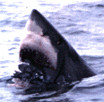|





|
The JAWS Monster versus reality....
Under various synonyms (such as Maneater and White Death),
the white shark has long been a focus for negative media
attention, generated by its sometimes lethal interactions with
humans and boats.
As a consequence of this typically exaggerated threat to
human safety and an almost legendary 'Big Fish' status, the
species is deliberately targeted as a source for
sportsfishing, commercial drumline trophy-hunting whereby
jaws, teeth and even entire specimens are preserved.
Often, their demise comes about merely as piscine
whipping-boys of macho individuals pandering to shark attack
paranoia.
All of these activities have greatly increased since the
JAWS media phenomenon of the mid-1970's - and not merely to
the detriment of of the great white.The targeting of other,
less high-profile species of sharks has also become vogue.

Nowhere is
the great white abundant enough to sustain long-term directed
fisheries, with the majority of annual captures worldwide
being made incidentally through commercial fisheries operating
longlines, setlines, gillnets, trawls, fish-traps and other
gear.
The white shark is ensnared throughout the water column in
nearshore fisheries and occurs, albeit much less frequently
than other mackerel sharks, in the by-catch of some offshore
oceanic pelagic fisheries.
White sharks readily approach boats, scavenge from
fishermens nets or longlines and devour hooked fish taken by
rod-and-line or swordfish harpoon.
Contrary to game hunter bravado, there is nothing
particularly clever in enticing these sharks up to boats.
Indeed, this vulnerable propensity towards curiosity often
results in either their own accidental entrapment or
deliberate killing by fishermen.
In certain regions the white shark has traditionally been
viewed only negatively, as manifesting a costly interference
to fisheries by damaging gear and 'stealing' catches.
Overall population estimates are unknown, although a recent
regional estimate for the famous Dangerous Reef population
(South Australia) is given as 200 individuals.
This rare species is unquestionably vulnerable to directed
exploitation such as sportsfisheries and the curio trade.
The overall, long-term impact of these mortalities coupled
to those caused through indirect fishery captures or
indiscriminate anti-shark beach meshing is possibly
far-reaching.
The removal of even a few individuals apparently has very
tangible effect at discrete localities. Habitat
degradation (pollution and overfishing) also threatens this
species and may largely exclude it from areas, perhaps
traditionally utilised for feeding or as nurseries,
where it was historically much more abundant.
|




